Last updated: 28 March 2004
|
Last updated: 28 March 2004 |
Some ETX users have sent me examples of their astrophotography. If you have some examples you would like included here please send me a description of how you made the astrophotos and a copy of the images as GIF or JPEG files (due to internet email gateway issues, please send only one image file per message). Send to etx@me.com. Alternatively, if you have created your own web page with your examples please let me know and I'll include a link to your site. You will also find astrophotography examples on the Helpful Information - Astrophotography page.
| Douglas Cockerham (padredos@pacbell.net) [28 Mar 04] |
|---|
|
First let me say that I really appreciate your site and the work you put
into it. The information contained within is extremely helpful. Because
of your site I was able to get up and running very quickly. I am
completely new to all of this, but with your help and the help of all
who have contributed I am able to make the most of my time under the
stars.
I have a page on my website devoted solely to my new found passion (astronomy) and thought maybe you or some of the people who frequent your site would be interested in some of the photos I am capturing. Here's the URL: http://www.cockerham.org/Astronomy/astronomical_gallery.asp. If you ever have a chance to stop by and have a look. If you feel so inclined, let me know what you think. I put together a short animation of tonight's transit of Ganymede and Io that is interesting and posted it on my site. Unfortunately, the heavy dew cut my plans short so I was only able to get the first hour and a half. But it turned out OK. Thanks for helping me out, your site is truly the best resource for any owner of an ETX scope. |
| Tommy Lim (kangwen@tm.net.my) [28 Mar 04] |
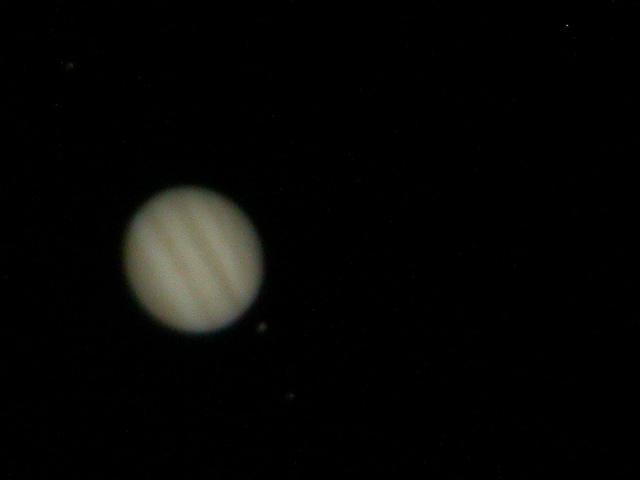 |
|
These are my latest photos of jupiter.
I am using my new set of ETX125 with nikon cp4500, without any
modification by photoshop.
|
| leutloffa@juno.com [28 Mar 04] |
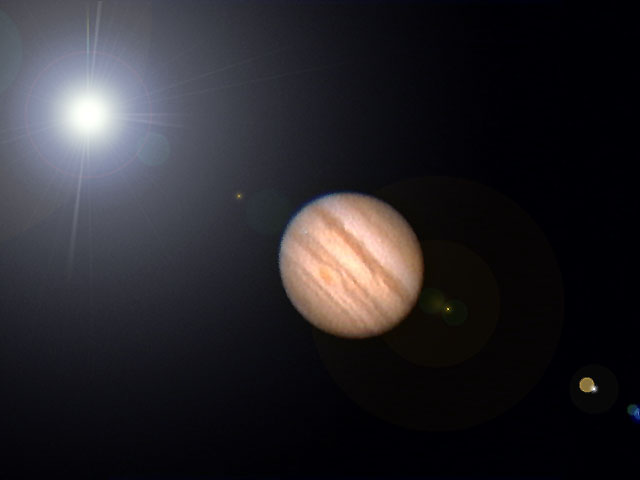 |
|
ok this pic is a little artistic...but I thought pretty cool nevertheless. It is a pic of the GRS taken on 3-24-04 thru my
ETX 125, 600 images stacked with Registax. The resulting image was then enhanced with an unmask filter in Adobe Photoshop Elements and the sun glare added using the filter "lense glare". I think that gives the photo an interesting perspective!! |
| BurrDMB@aol.com [28 Mar 04] |
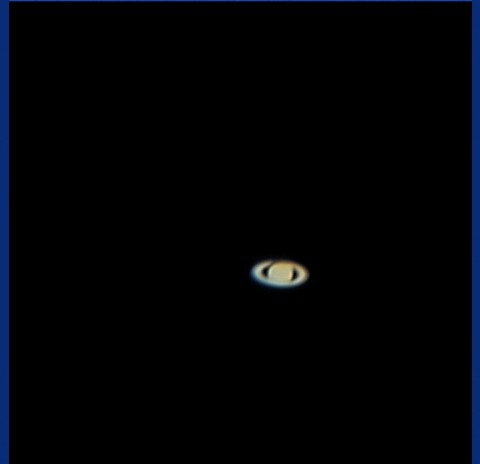 |
|
First attempt last night with my new ETX and Phillips Toucam - managed to get a reasonable picture of Saturn using Registax 2 software. (I've sent an attachment for your gallery though there are probably many better!! - anyway I'm delighted with my first attempt)
kind regards from Wimborne |
| leutloffa@juno.com [28 Mar 04] |
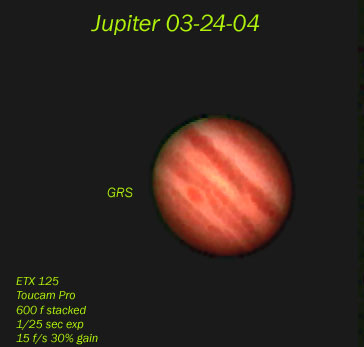 |
|
here is my best pic to date of Jupiter and the GRS. Taken 3-24-04 with ETX 125 and Toucam Pro at 15f/sec, 1/25 sec exp, 30% gain, 600 frames stacked in Registax. A little tense moments this evening (out of control prescribed burn)...and I thought it was going to be the fires of last summer all over again!! Started making preps for evacuation again...after family loaded, then telescope!!!
|
| geheniau@xs4all.nl [25 Mar 04] |
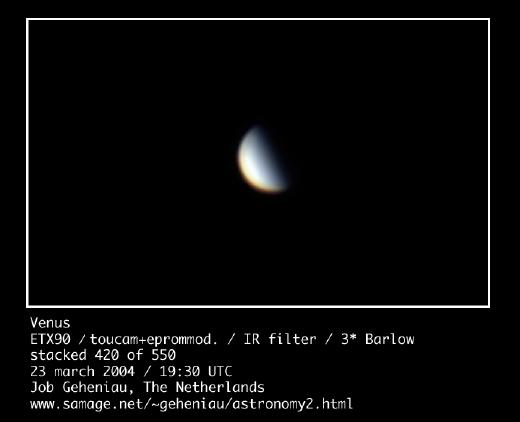 |
|
I really can advise everybody to do the eprom update I send you last time
for the webcams.
Less noise and sharper pictures!
|
| geheniau@xs4all.nl [25 Mar 04] |
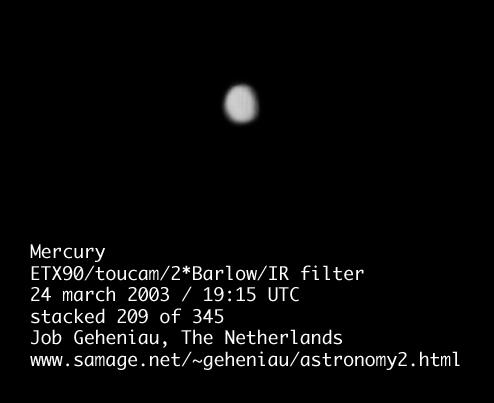 |
|
I hope I don't bother you too much with my pictures, but I am hooked on the
ETX and I hope people see that a lot is possible with the Mighty ETX.
I did Mercury for your planets galery. This one I don't see very often on
the ETX site.
I can tell you, this is really difficult. Little time to capture and low on
the horizon and only a few weeks to try, so every clear night is being
outside :-)
Again I hope to see some more of this planet from other users.
Let's get the ETX's running!
|
| "Dirk Henrich, Dr.phil.nat." (d.henrich@trauma.uni-frankfurt.de) [25 Mar 04] |
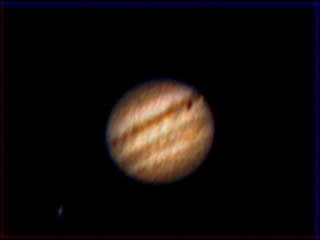 |
|
thanks once again for your informative and fruitful website. Please find attached an image of Jupiter taken at march the 17th 07:30 pm.
You see Io and his shadow as well as the great red spot. I used an ETX90EC, 2xBarlow and an Phillips ToU-Cam. I added about 150 frames from 2000 using Giotto.
Dirk from Frankfurt |
| nicolas.champaud@bnf.fr [25 Mar 04] |
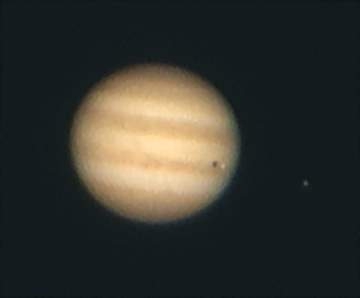 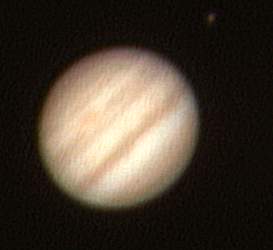 |
|
Those 2 pics were taken on the 8 and 16 march.
(I used the same stuff as usual), turbulency was not that good :(.
|
| leutloffa@juno.com [25 Mar 04] |
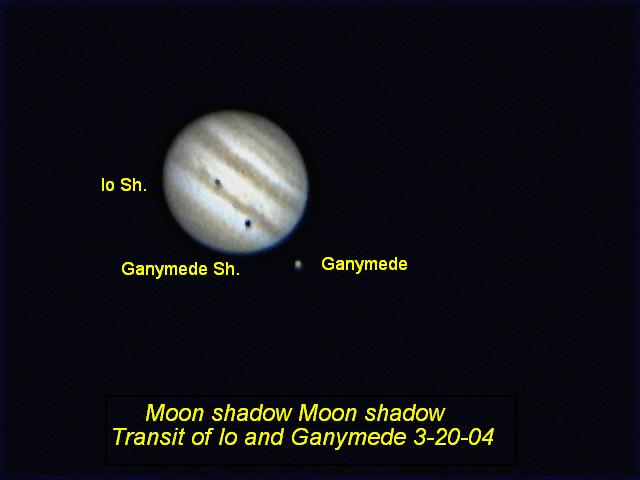 |
|
had the ETX 125 and my Phillips Toucam working overtime this Saturday night with the dual transit of Io and Ganymede. This pic captured 450 frames (15f/s)at 1/25 sec exp using auto exposure and 0% gamma. Frames were stacked in Registax...and layers slightly tweeked. Had alot of fun with this one and looking forward to the triple transit at the end of the month. Alan
|
| Greg Nolan (gwiz_32@yahoo.com) [22 Mar 04] |
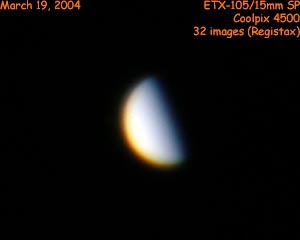 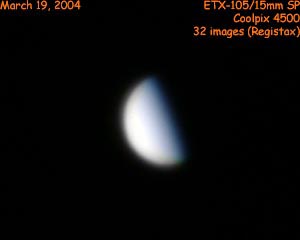 |
|
Someone (I can't remember who) asked that we try to
get shots of Venus, so here is my first attempt. There
is alot of red on the side because I did not allow
ample time for the scope to cool down. If I had, Venus
would have been gone. Maybe next time.
Also, I am really impressed with the results that many people are getting with video cams, but don't you think there should be a separate category for them - maybe called astrovidegraphy :) Just kidding, but really...it seems that it is much easier to get better quality results using a video cam, although it looks like they may be screwed when it comes to deep space objects that require long shutter speeds. I think they will get tired of only being able to get pictures of planets, the sun, and the moon. I prefer the challenge of actual photography myself....just a thought. By the way, I see that you have not updated your astrophotography section in quite a while. What's up with that?? Have you lost interest in the astrophotography or does the burden of maintaining your websites remove from your opportunities. If it is the latter, I hope you will reorganize your priorities to place more emphasis on doing more of the things you enjoy. I appreciate (like everyone) your maintaining this website, but not at the expense of taking away from your passtimes. I hope for your good skies, [Right] Here is a resubmission of my Venus pic (amazing what you can do with a red eye tool). Mike here: As to my photography, I did some with the LPI (as reported on in the article "Autostar Suite on a Macintosh" on the Autostar Info page. But weather and time have not been very cooperative for more. |
| Bill Dirks (bdirks@pacbell.net) [15 Mar 04] |
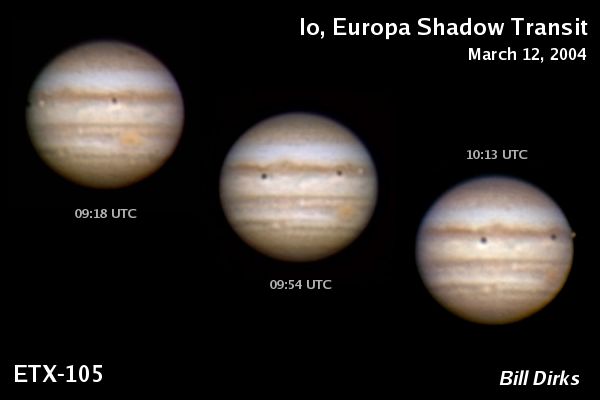 |
|
For your Guest Planets gallery, here are three images from March 12
showing the progress of the double shadow transit on Jupiter. The left
hand shadow is Io, right-hand shadow is Europa. In the first image you
can clearly see Io to the right of its shadow. In the other two images
you can see Europa, but Io is lost against the brighter clouds of Jupiter.
ETX-105, Meade #140 2X Barlow and color CMOS image sensor at prime
focus. Barlow and camera installed in the rear port with a Scopetronix
visual back. Each image is about 250 stacked exposures selected from
about 450 captured over a 2 minute period. 290ms exposure. Stacking in
Registax, final work in The GIMP.
Index of my ETX astrophotography: http://www.thedirks.org/astro/
|
| Peter Roelofs (p_roelofs@planet.nl) [15 Mar 04] |
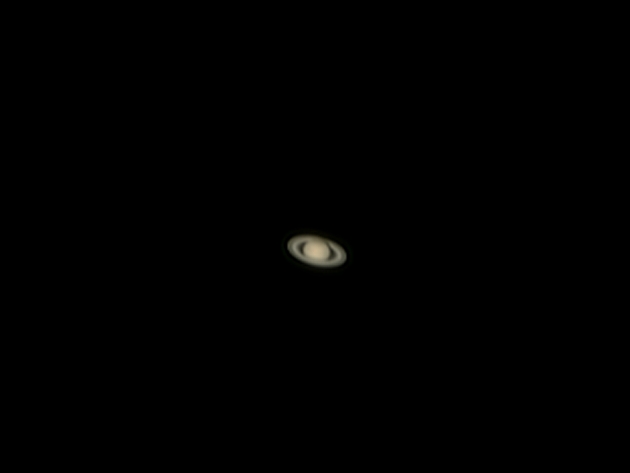 |
|
I recently bought an ETX-105 and am very happy with it. Best decision I
made in a long time. Because of the bad weather since I bought the scope
(guess that comes with buying a new scope), I havent been able to have
that much fun with it yet.
When I did get around those few times the weather was good, I also tried
my webcam on the scope and I'm sending you my best result with Saturn
sofar. I dont know all the details anymore but I stacked it in
Registax, did something with the wavelets and then some fine-tuning in
Photoshop Elements.
Hope you like it and will post it, in the guest astrophoto gallery, on
your site, which teaches me new things everytime I visit.
Best regards and clear skies, Peter Roelofs The Netherlands |
| leutloffa@juno.com [15 Mar 04] |
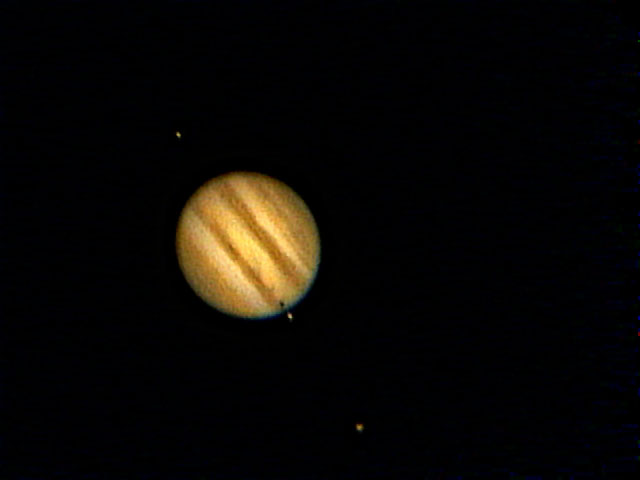 |
|
here is what I think is my best pic yet of Jupiter. Three mmons visible in pic (from left to right...Europa, Io and Ganymede...Io is casting its shadow on the edge. Shots taken with my ETX 125, and Phillips Toucam Pro...1/15f/sec, 1/50 sec exp...recorded 120 sec and stacked using Registax (90% quality and minor layer enhancement).
|
| astro (astro@l2l1.com) [11 Mar 04] |
 |
|
Attached is my best results of latest Jupiter opposition, and Saturne late
january.
All have been made with ETX90EX, ToUcam and Barlow 2x. Post processing have
been stacking and wavelet. The sky is a urban condition (over Paris from my
viewpoint).
Hope you will find them good !
|
| Kuba Malecki (kubamalecki@i-net.com.pl) [8 Mar 04] |
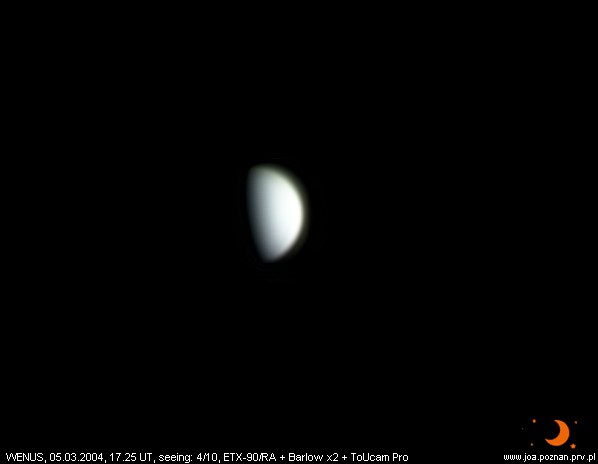 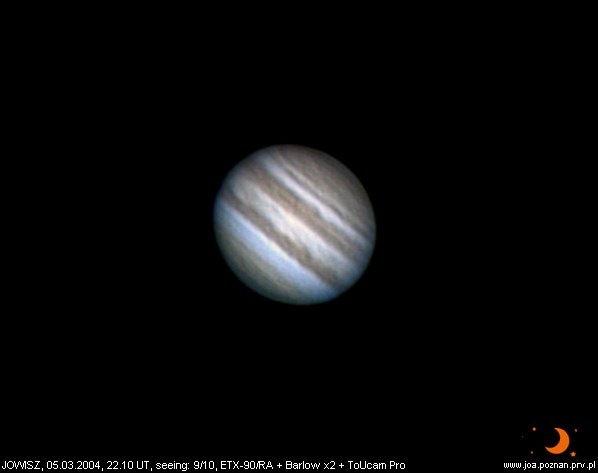 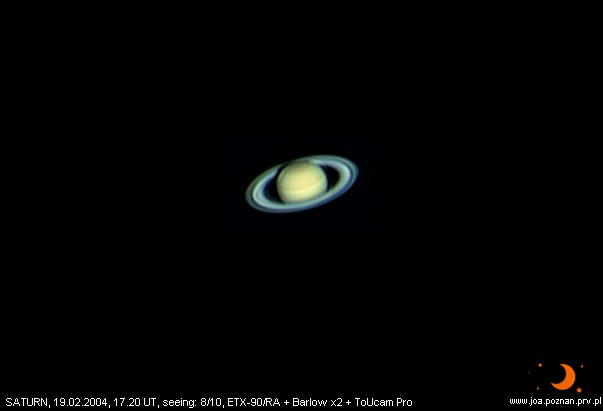 |
|
I send you my recent photos of Saturn, Venus and Jupiter. I used my
ETX-90/RA, Barlow x2 and ToUcam Pro. For Saturn I used about 1200
frames, Venus about 1000 and for Jupiter 600. All avis recorded at
5fps, stacking and "waveleting" in Registax 2.1., further processing
in GIMP (levels, saturation and other color enhancement). Jupiter was
resized to 150%, Venus to 200%. More pics on my webpage:
www.joa.poznan.prv.pl
|
| Dieter.Wolf@DNSint.com [8 Mar 04] |
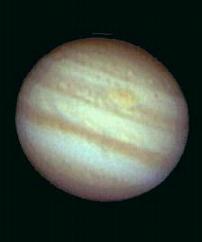 |
|
as most of us I had to give our 'great one' my salute too at his opposition
day and look into his 'orange-red eye'...
Dieter Wolf (Munich, Germany); 2004-03-04 23:15 CET (22:15 UTC); MEADE ETX-125EC with 2x Barlow Lense and PHILIPS ToUCam pro (300 out of 760 frames; should have been more, but tracking wasn't so good); south up, east left The GRS in the STB is bright and colorfull (I think it's easier to see than in the years before, isn't it?) and you can imagine the clouds spinning around; white spots in the STB, black ones in the STeZ and then again whites, festoons in the EZ... Lot of details for our range of small telescopes. As ever, the southern hemisphere shows more details than the northern one. Once more thanks for providing astro-amateurs around the world such a great forum to meet... |
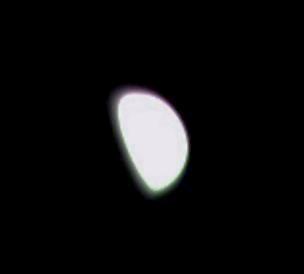 |
|
on 'special demand' of our friend Job Geheniau who wants to see more shots
of Venus...
Dieter Wolf (Munich, Germany); 2004-03-04 19:10 CET (18:10 UTC); MEADE ETX-125EC (1/100s; 150 frames out of 250); south up, east left Venus shows no structure or details in her clouds but phases similar to those of the moon. With about 65% illuminated that's something like 'first quarter'. But other than with our moon the phase will DECREASE as Venus moves closer to us heading towards lower conjunction. So the illuminated part will decrease within the next two months whereas the size will increase from half the size of Jupiter (what it's now) to approximately Jupiter's size. So in May we will see pictures of a large but very thin Venus. |
| nicolas.champaud@bnf.fr [4 Mar 04] |
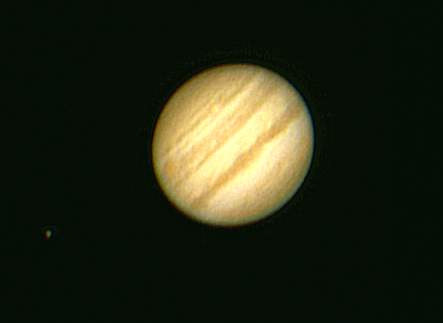 |
|
This is my first for Jupiter!
I took it on the night of the 2nd of march with my etx-125, a 2x apo barlow and
a Toucam pro.
Nearly 500 frames were stacked with registrax to obtain the final image.
|
| Chris Suddell (chris.suddell@phoenixdb.co.uk) [4 Mar 04] |
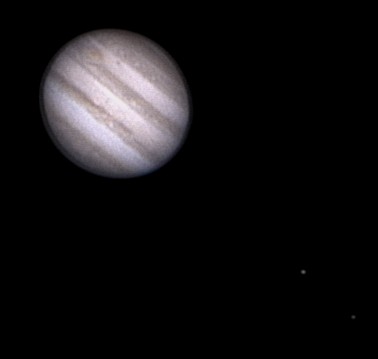 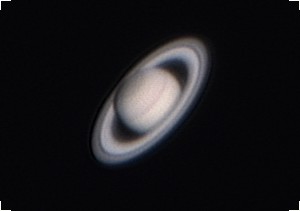 |
|
I've attached two pictures taken last night with an ETX125 and 2x Barlow. They were taken from London England. Both images processed in Registax. The Saturn image was only about 190 frames; Jupiter was 432 frames both at 5fps, no gamma. The web cam was a Vesta Pro 680k and Astronomik IR Filter.
|
| geheniau@xs4all.nl [4 Mar 04] |
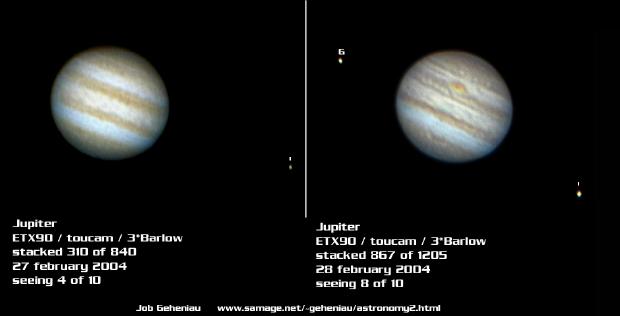 |
|
And at last the one I am really proud of! It was a night with normal seeing and a night with very good seeing. Seeing is the most important thing while taking pictures with a telescope. You can see the difference. Jupiter. I think it will be very hard to get a better picture with my ETX90 of Jupiter. To get such a kind of picture takes a lot of patience. A 3*Barlow on a toucam with an ETX90...takes me 15 minutes to get Jupiter steady in the middle on screen! One little movement and it's gone. Thanks for reading and posting these pictures on your site. I hope it will stimulate more people for astronomy and especially getting the most out of the ETX. Job Geheniau The Netherlands |
| leutloffa@juno.com [26 Feb 04] |
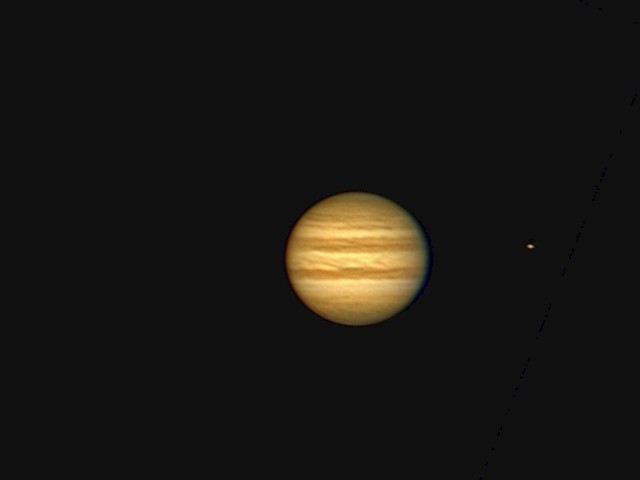 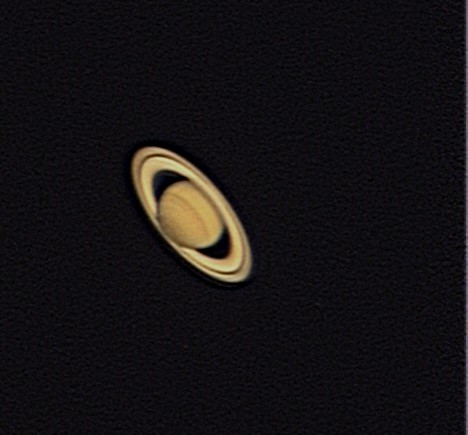 |
|
Great article in Sky and Telescope (April Issue) by the creator of Registax. I am amazed at the results by following the step by step instructions.
[Top] Attached is a reprocessed (prior pic) of Jupiter utilizing layer sharpening. The results are wonderful!!
[Bottom] Here is a prior pic of Saturn (originally taken 1-10-04) enhanced in Registax by sharpening layer 1 and 2 in teh Wavelet Scheme. Great results as a result of Cor Berrevoets article in Sky and Telescope (April). Can't wait for clear skys again!! |
| geheniau@xs4all.nl [20 Feb 04] |
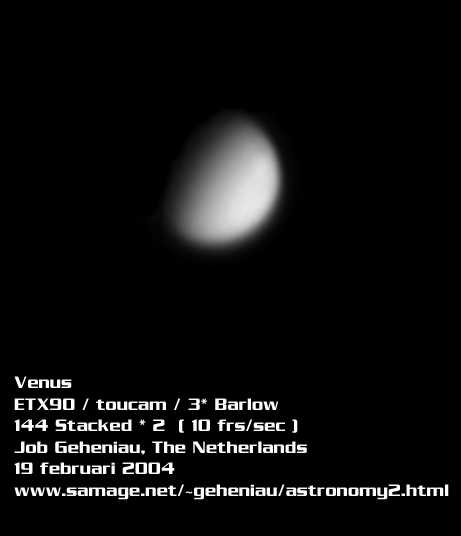 |
|
And for your guest astrophotography Planets now something different than
Saturn and Jupiter....Venus. It's possible with an ETX90 this way. A little
patience and some good stacking.
Hope to see some more Venus on your side from other users. It's a
challenge, because it's a little bit harder (and some people think less
interesting planet, I don't agree) to do.
Thanks and keep up the good work, Job Geheniau The Netherlands |
| Dieter.Wolf@DNSint.com [20 Feb 04] |
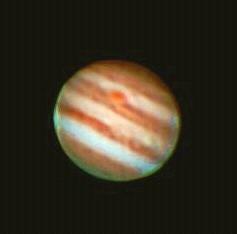 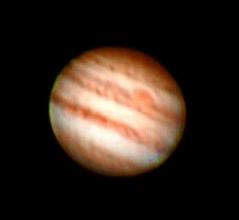 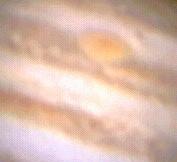 |
|
it is snowing outside of my window now while I write this mail to you.
Normal weather for that time of the year in Germany. But two days ago we
had a clear night with stable air layers (nearly no twinkling of the
stars!). This gave me - as I think - some really good shots of Jupiter.
Dieter Wolf (Munich, Germany); MEADE ETX-125EC (5", 1900mm) with PHILIPS ToUCam pro at prime focus; south up, east left [Left]: 16.02.2004 23:45 CET (22:45 UTC); 2x Barlow; 500 out of 750 frames [Middle]: 17.02.2004 00:30 CET (23:30 UTC on 16th); 2x Barlow; 1000 out of 1600 frames [Right]: 17.02.2004 00:05 CET (23:05 UTC on 16th); 3x Barlow; 500 out of 900 frames The GRS is pretty well visible. Have a look how quickly it has moved in 45 minutes between the pictures one and two. The quick rotation of Jupiter is the reason why we have to take care to NOT sample frames for a too long time. Roughly calculated: 45" (equatorial diameter) rotate in 5h (half of rotation time); so an .avi file of 1000 frames with 10 fps is still fine (about 0".25 movement); 2000 frames with 5 fps (about 1" movement) is really bad. Besides the GRS you see A LOT of dark and white spots and bars and festoons located in the different bands and zones of the planet. What astonished me is a large storm between the NEB (northern equatorial belt) and the EZ (equator zone) west of the GRS (down-right on the pictures) It is about the same size and form as the GRS (40.000 km) but much less colored and somehow diffuse. I never saw that before. Thanks for your efforts Mike |
| TaToCaNa (tatocana@terra.es) [16 Feb 04] |
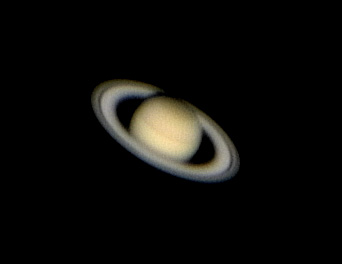 |
|
Here my last Photo of Saturno.
It was made with MEADE ETX-125 /Prime Focus + Barlow x2/ AVI 30s / Registax on 13 of Febrary 2004
|
| James Jefferson-Wilson James (james.jefferson@bbc.co.uk) [16 Feb 04] |
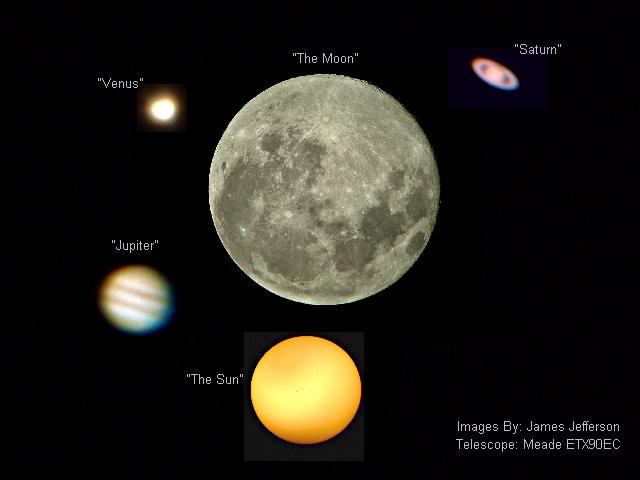 |
|
Please could you consider for your planets gallery.
|
| Dieter.Wolf@DNSint.com [12 Feb 04] |
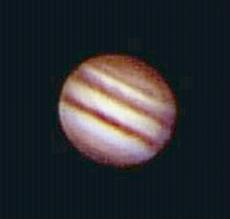 |
|
here is - for the moment - my last picture. After a week of extraordinary
warm spring weather in Southern Germany (I observed during the night in a
short-sleeved shirt) we returned to normal winter weather conditions again
(stormy, freezing, snow...it's Germany, not California)
Dieter Wolf (Munich, Germany); 2004-02-05 23:00 CET (22:00 UTC); MEADE ETX-125EC (5", 1900mm) with PHILIPS ToUCam pro at prime focus; 700 out of 1800 frames resized by 2 during stacking process; south up, east left The 43*40" disc of -2m.4 bright Jupiter - still too low above my neighboring houses during 'normal' observation times - shows some dark festoons stretching from the Southern Equatorial Belt into the Southern Tropical Zone. Above that - in the Southern Temperate Belt - we have a large, dark bar on the west side and in the Equatorial Zone some week turbulances can be seen too. Hopefully the coming months will provide us with a nice Jupiter season. |
| Taun Deverill (cactus-flier@cox.net) [8 Feb 04] |
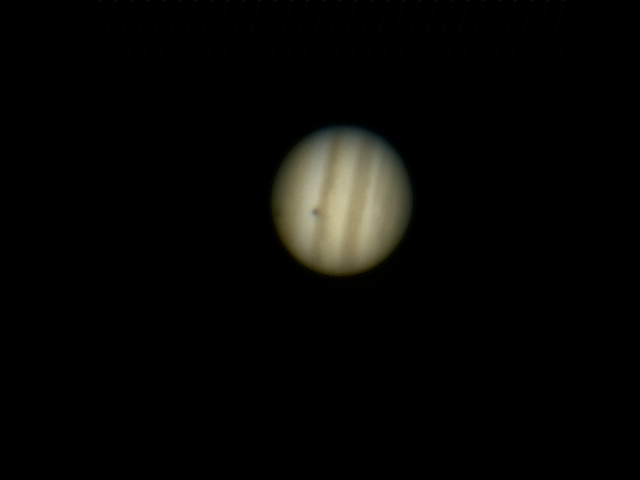 |
|
Attached is a picture of Jupiter taken on Feb. 6, 10:41 p.m. mountain time
from Phoenix area. The black dot is the shadow of the moon Callisto and you
can make out Callisto on the limb of the planet. I was surprised about
capturing the moon itself. Equatorial bulge is also quite apparent. The
information was check with Starry Night. Photo is taken by ETX-125EC, 2x
barlow, Logitech Quickcam Pro and 156 pictures out of 949 stacked and
processed using Registax 2.1.
|
| Alan Leutloff (leutloffa@juno.com) [8 Feb 04] |
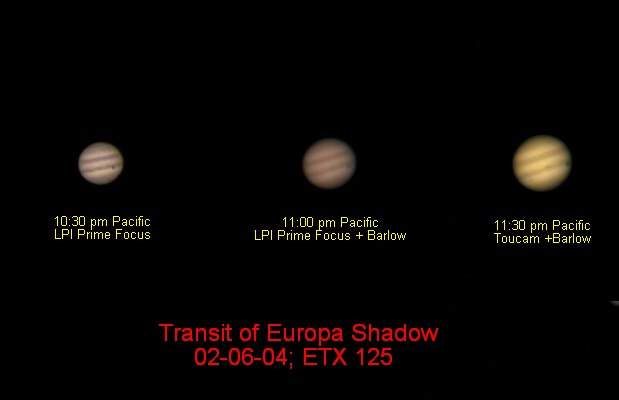 |
|
This is the coolest thing I have recorded yet. On Feb 6th...I
set up my ETX 125 and took a 3 sets of pics beginning at 10:30 PM. The
first was using the LPI at Prime Focus (50 stacked images), Next at 11:00
PM I added the barlow lens with the LPI and recorded another composite of
50 images with the LPI. Finally, at 11:30 I attached my Phillips Toucam
Pro and recorded and stacked (Registax) over 1500 images (10 fr/sec).
After I compiled all three images...a dark spot was apparent moving
across Jupiter. I remember reading in Sky and Telescope magazine about
the transit of the shadow of Jupiter's moons during the month of February
(Feb issue pg 66)...and lo and behold...that is what I captured!!! So
attached is a composite of my images and you can clearly see the shadow
moving across the face of Jupiter. This is my proudest moment!!!
|
| geheniau@xs4all.nl [4 Feb 04] |
 Click for full-size image |
|
Because it's now a year ago since I started with my ETX90, here a sample of
my best pictures of the planets (and moon) with my ETX90 (not to scale!).
Only Pluto is missing (will be a hard one with the ETX90 I think).
In (near) future, Mercury and Venus will be renewed I guess but this is the
result so far.
Job Geheniau The Netherlands |
| Jody Miller (mlite20@yahoo.com) [31 Jan 04] |
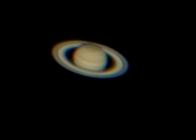 |
|
Meade ETX90 Alt/Az mode Tracking,
Meade LPI,
2x Barlow,
200 pics stacked
This a pic of Saturn I took on 1-26-04. I just got the Meade LPI and I am impressed with the results. Thanks for a great site and I will be sending more pics. J.Miller |
| Dieter.Wolf@DNSint.com [31 Jan 04] |
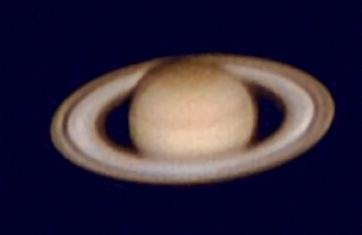 |
|
here is a second 'shot' of Saturn on one of that TWO CLEAR NIGHTS we had
during the last 6 weeks...
Dieter Wolf (Munich, Germany); MEADE ETX-125EC with 2x Barlow lens (3900mm); Philips ToUCam pro at prime focus; 2004-01-22 23:30 CET (22:30 UTC); 1100 out of 1500 frames 1/25s each; south up east left And we still have that open question: 'Why do we see Cassini's division? We have to distinguish between 'what can we RESOLVE' and 'what can we SEE'. We can NOT resolve the Cassini division, that means we do not see any details in it. But we 'recognize' that 'there is something'. Make a simple test. Take a piece of paper and a pencil. Write equidistant dots, horizontal and vertical lines on that paper. On a second paper just draw a cross from top to bottom and from left to right. If you go back from these papers you will reach a distance where first you can no longer resolve the dots. Go one step back more and you can not resolve the horizontal lines, shortly after that the vertical lines. BUT you still see the cross on the white paper. By the way, we all 'see' stars, which are far far beyond what our eyes can 'resolve'... |
| PVerandas@aol.com [25 Jan 04] |
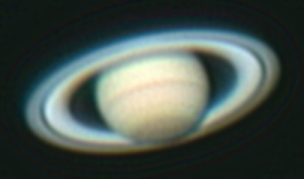 |
|
Saturn taken last night (1-24-04) about 10:00 pm. Recorded about 1200 frames and stacked using K3ccdtools. ETX 125 and vesta pro camera
|
| Dieter Wolf (WolfDieter@t-online.de) [25 Jan 04] |
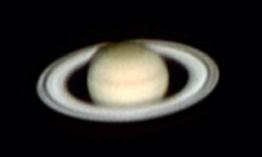 |
|
after 4 long weeks without a single clear night where I felt like an addict that has been taken away his drugs, finally we had a beautiful, cold clear night that I used to take a look at Saturn. Culminating at 64 here in Munich, Saturn with his -0m.5 is a bright, fantastic view.
Dieter Wolf (Munich, Germany) 2004-January-22nd 23:35 CET (22:35 UTC) [remembering the discussion you once had with that guy saying there is only one 'correct' format for date and time: from top to bottom...] MEADE ETX-125EC (5" Maksutov-Cassegrain, 1900mm focal length) with 2x Barlow (3800mm) Philips ToUCam pro at prime focus 700 out of 1100 1/25s exposures aligned, stacked and optimized with K3CCD, IrfanView and PaintShop [south up, east left] You nicely see the bright B-ring separated from the outer A-ring by the Cassini division. You only have a vague idea of the very weak B-ring. In front of the planet is the shadow of the ring system and the shadow of the planet on the rings now points a little bit to the left (east) as we passed opposition (compare it with pictures that have been taken before opposition) One colored belt on Saturn can be seen easily, a second one is there too if you look very precisely And finally the dark southern polar region. And now something to think about it: Why do we see the Cassini division? Because we look at it - no, not a joke, seriously. The Cassini division is an area in Saturn's ring system where there is only very little 'material'. The extension of this area is round about 4200 km. Saturn's equatorial diameter is round about 120.000 km and appears now at an angle of 20".6 4200km/120.000km*20".6=0".7 Mmh, have a look at your telescope's handbook or use the simple formula '115(arcs/cm)/clear aperture(cm)' to estimate the maximum resolving power. You will find 0".9 for the ETX-125 down to 1".6 for the ETX-70. If Saturn's B- and A-rings were double stars we would NOT be able to separate them in an ETX-125, BUT we can see Cassini's division even in an ETX-70. The question is WHY? |
| James Jefferson-Wilson James (james.jefferson@bbc.co.uk) [22 Jan 04] |
 |
|
Took this picture on Saturday 17th January, lovely clear night In the UK. Tried Jupiter many times but I am very
Pleased with this. Contrast/Brightness/Unsharp Mask used in PaintShop Pro 7. I am getting some filters and im
Hoping they will make the image better. All other info on picture. Could you consider for your planets gallery ?
With your experience of the ETX90, can you get a better picture with a filter using the Afocal Method ?
Your site is brilliant for ETX Users, keep up the good work ! Mike here: Filters will help bring out different details. If you then stack those you can improve the image.
And:
And more:
Mike here: Aligning the images (known as "registering") is one of the major chores of stacking. There is software that helps. Keith's Image Stacker (Mac OS X), and Registax and AstroStack (Windows) are typical examples. There is info on Registax on the Helpful Information - Astrophotography page.
|
| Alan Leutloff (leutloffa@juno.com) [19 Jan 04] |
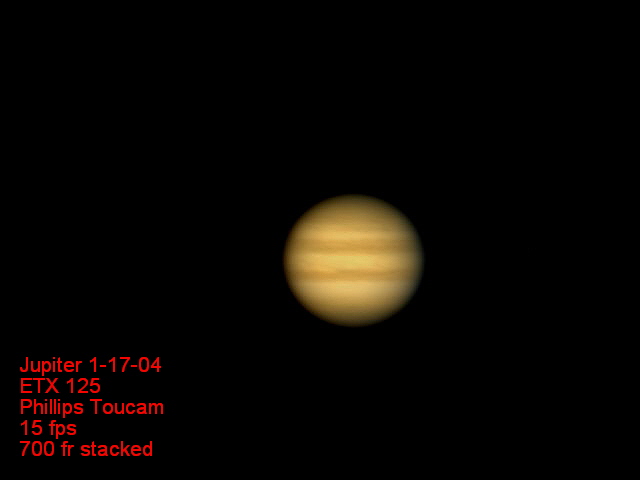 |
|
Here's my best toucam pic of Jupiter todate. Taken last night
(1-17-04) about 11:00 pm. Recorded about 700 frames and stacked using
Registax. I've come a long way from my initial pics when I started all
this this past summer.
|
| Olivier Cioni (olivier.cioni@wanadoo.fr) [19 Jan 04] |
 |
|
Here is shots of Mars, taken with my ETX105 in 2003. We can see clearly
the evolution of the distance of Mars from the earth.
|
| Bill Dirks (bdirks@pacbell.net) [19 Jan 04] |
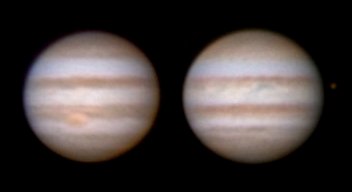 |
|
Here is Jupiter through my ETX-105. These images were taken 25 hours, or
2.5 rotations of Jupiter apart, so they show opposite sides. Left photo
Dec. 28 3:36am PST, right photo Dec. 27 2:33am PST 2003. Dec. 27 had
perfectly steady seeing and good transparency. Dec. 28 had some thin,
high clouds, and a little less steady, but I could still get a good
result. Captured with a color CMOS image sensor at prime focus. Stacked
in Registax. Final processing in GIMP. The faint dot to the right of the
right-hand picture is Io.
My ETX-105 Astrophotography Gallery is at http://www.thedirks.org/astro/ Thank you, Mike, for compiling and maintaining your ETX site. I know it's a lot of work. Much appreciated. Bill. |
| Martin Sidgreaves (martin.sidgreaves@btopenworld.com) [19 Jan 04] |
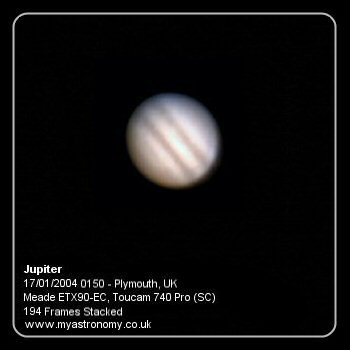
|
|
Thought I'd share a couple of photos I've taken over the last few weeks for inclusion on your gallery. Im still relatively new to astrophotography but I have been really happy with my results so far.
I've learnt most of the techniques from your site which is just such a fantastic source of information. Keep up the great work |
| Alan Leutloff (leutloffa@juno.com) [15 Jan 04] |
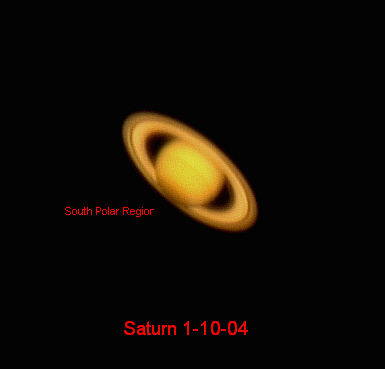 |
|
Here is what can be done from hand picking the better frames
from my Saturn AVI file. This shot was taken from the best 260 frames
(out of 700) using VDUB (Video editing freeware)...then processed using
registax. Note...no enhancement made with colors. Compare this to my
last pic which let Registax process all 700 frames. Also...just
repartitioned my harddrive on my laptop (was running out of room)...and
loaded the Meade LPI software...so next weekend...should be up and
running with the LPI.
|
| TIM CLARKE (tim14@btinternet.com) [15 Jan 04] |
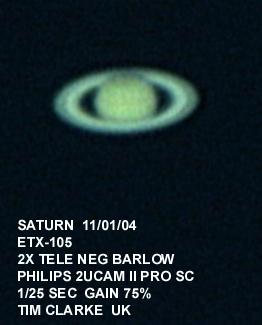 |
|
I would like to thank you for your informative web site, it has got
me started on astophotography.
This is my first atempt at saturn, thought you may like to post it in your
gallery. Keep up the great work Regards Tim Clarke, UK. |
| Alan Leutloff (leutloffa@juno.com) [11 Jan 04] |
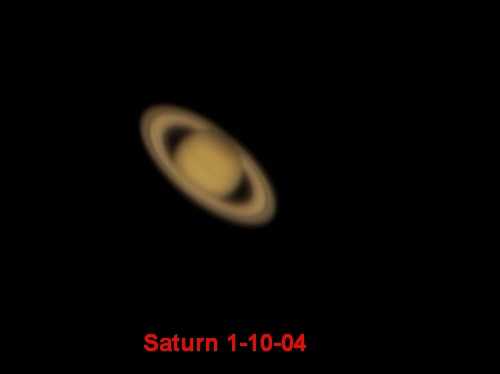 |
|
OK...I am quick on the learning curve. Here is by far my best pic so far
of Saturn. This on a very clear night taken with a Phillips Toucam Pro
set at resolution 640/480, 25 frames/sec and moderate gain and 1/10 sec
exposure. Recorded 600 frames and stacked on registax. No additional
enhancements to photo. This is great...and your website is the best
resource available. Thanks Mike.
|
| Alan H Leutloff (leutloffa@juno.com) [8 Jan 04] |
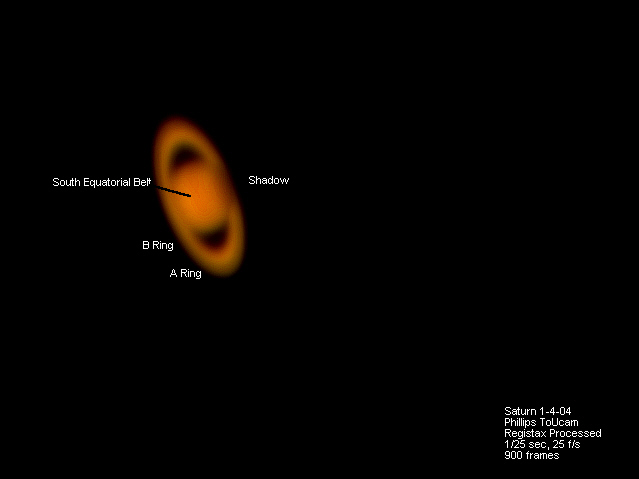 |
|
last night broke out the ETX 125 and the Phillips Toucam. This
shot was recorded at 1/25th sec exposure, 25 frames/sec. Processed 900
frames w/Registax....and color processing. Annotated with HP2100
software. This is sure fun...good thing I have a day job.
|
| Alan Leutloff (leutloffa@juno.com) [4 Jan 04] |
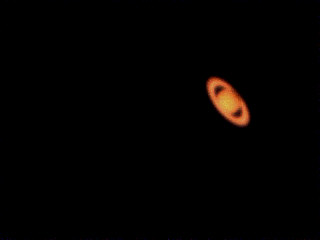 |
|
Here is my first ToUcam pic of Saturn...taken with my ETX 90M,
automatic settings at 25 f/sec...and processed (with color processing)
using registax. Braved 10 degree temps for focusing. I'm impressed with
my first attempt...and hope to set up the ETX 125 later this week. Happy
New Year.
|
| geheniau@xs4all.nl [4 Jan 04] |
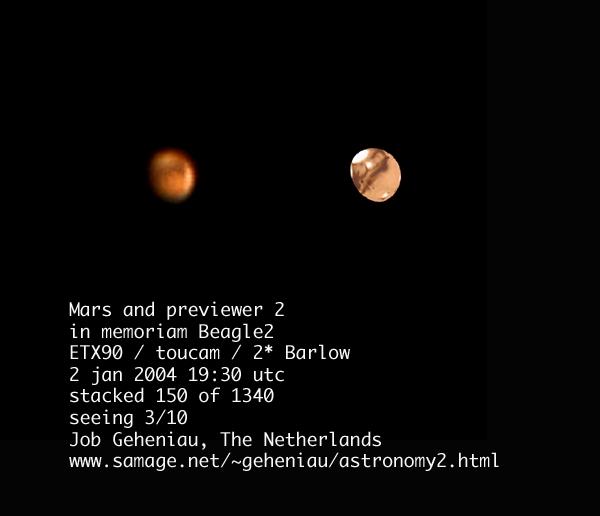 |
|
Planet Mars. Now difficult to get, but due to all the hypes with Rovers,
Mars Express and Beagle2 I just want to do a last shot this year of Mars.
Job Geheniau The Netherlands By The Way: Bad Seeing and bad transparancy this night. |
| Niall Saunders (niall@njs101.com) [4 Jan 04] |
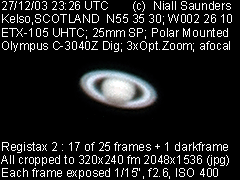 |
|
Hi Mike (and thanks, and keep up the good work!!),
I have had my ETX-105 since 23rd Dec 2003, and have had three nights viewing since!. However, I managed to get a decent night observing Saturn (about 6/10 viewing) and used my new, home-made, afocal adaptor on my ancient and battered Olympus C-3040Z (now running at over 14,000 pictures, from South Pole to North Pole, and round the world twice !!). I have also had a first attempt at using Registax2 and am reasonably impressed with the result - shown here. Now, when the skies clear, I will be looking to try the (now modified) adaptor on a higher power lens - hopefully with minimal vignetting, and see if I can get a better image before Saturn shrinks from her present glory here in NE Scotland. After that: I aim to machine up an adapter for the back of the ETX-105, to allow me to get a dismantled webcam into the light-path. Wish me luck and clear skies!! |
| Howard Visser (howard.visser@cgi.com) [4 Jan 04] |
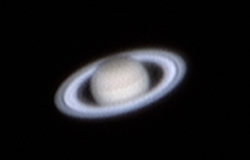 |
|
Happy New Year! Here's my latest attempt at imaging Saturn using my
ETX90 with a 2X Barlow and Logitech Quickcam Pro 4000. The image file
was captured on Dec 28th using an exposure of 1/5 second at 5 frames
per second for 30 seconds. The image file was processed using RegiStax
and selecting the best 80 frames to create this final image. It turned
out so well that that only minimal post processing of the image was
required. The image shows the Cassini divsion and what appears to be
the C ring on left hand side of Saturn.
|
Return to the top of this page.
See the Guest Planets Archive 2003 for photos posted October-December 2003.
See the Guest Planets Archive 2003 for photos posted August-September 2003.
See the Guest Planets Archive 2003 for photos posted January-July 2003.
See the Guest Planets Archive 2002 for photos posted in 2002.
See the Guest Planets Archive 2001 for photos posted in 2001.
See the Guest Planets Archive 2000 for photos posted in 2000.
See the Guest Planets Archive 1998-99 for photos taken 1998 and 1999.
Go back to my ETX Home Page.